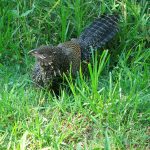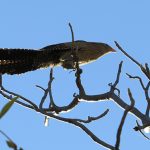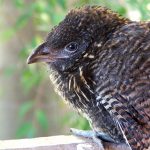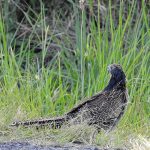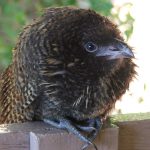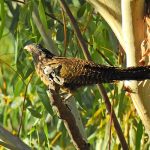PHEASANT COUCAL
The Pheasant Coucal: Guardian of the Understory
In the diverse tapestry of the Australian landscape, the Pheasant coucal emerges as a fascinating character. This unique species of cuckoo, which graces both Australia and Papua New Guinea with its presence, is a member of the extensive Cuculidae family, a group renowned for its diverse and often mysterious cuckoo relatives. The Pheasant coucal is also affectionately referred to as the swamp pheasant, rainbird, or copper coucal, each name reflecting a different facet of its intriguing nature.
Appearance: A Bird of Earth and Fire
Possessing a statuesque medium build, the Pheasant coucal boasts a long, expressive tail and rounded wings that complement its slightly curved bill. Its plumage is a tapestry of earthy browns, interwoven with iridescent copper and deep black. Crowning its head is a bold black cap, while its eyes glimmer with a striking ruby-red brilliance, like tiny embers in the shade.
Males and females are similarly dressed, though males tend to be slightly larger. When seen in motion, their long tail feathers fan out behind them, adding to their pheasant-like grace—a quality that likely inspired one of their common names.
Habitat: The Hidden Realms
These elusive birds thrive in a range of habitats, from wetlands and swamps to mangroves, grasslands, and woodlands. They show a particular fondness for dense undergrowth, where they slip quietly between tangles of vines and shrubs. To the casual observer, they may seem almost invisible, preferring the protection of green shadows to the open air.
When the air is heavy with humidity, or after summer rains, the Pheasant coucal makes its presence heard. Its deep, resonant calls echo across the landscape: a rhythmic “ook-ook-ook” or “book-book-book” that rises and falls like the beat of a distant drum.
Diet and Foraging: Hunters of the Understory
Unlike many of their cuckoo kin, Pheasant coucals do not rely on other birds to raise their young. Instead, they are ground foragers, moving deliberately through the grass and leaf litter. Their diet is varied:
- Insects such as grasshoppers, beetles, and caterpillars
- Small reptiles, including skinks and geckos
- Tiny mammals, such as rodents
- Occasionally, they will take frogs or even the eggs of other birds
Their long tail aids in balance as they weave through dense foliage, while their robust bill equips them to seize wriggling prey with precision.
Breeding: A Family Commitment
In the world of Pheasant coucals, partnership is everything. They are monogamous, forming strong pair bonds that often last beyond a single breeding season.
- Nest: A large, dome-shaped structure of sticks and grasses, carefully tucked into low shrubs or thick vegetation for concealment.
- Role reversal: Unusually for birds, it is the male who shoulders the greater responsibility. He incubates the eggs and tends to the chicks, while the female assists with feeding. This cooperative approach ensures the survival of their young in a world filled with challenges.
Range and Distribution
The Pheasant coucal’s range extends across diverse regions of Australia:
- Eastern Australia: From Cape York Peninsula down the east coast into New South Wales
- Northern tropics: Across the Top End and northern Queensland
- South-western fringes: Populations occur in isolated patches, even in more arid landscapes when cover is available
They are also found in parts of Papua New Guinea, highlighting their adaptability across different climates and ecosystems.
Conservation: Guardians of the Green
Despite their adaptability, Pheasant coucals face mounting pressures:
- Predation by introduced species such as foxes, cats, and dogs
- Habitat loss through land clearing, urban expansion, and agriculture
- Climate pressures, with altered rainfall patterns potentially affecting their breeding success
While currently not listed as threatened, their reliance on dense vegetation makes them vulnerable to habitat fragmentation. Protecting the tangled, green spaces they call home not only secures their future but also safeguards countless other species that share these habitats.
A Symbol of Resilience
The Pheasant coucal is more than just a bird of the shadows. It is a symbol of resilience, an understated guardian of the understory, reminding us of the delicate balance that exists in Australia’s ecosystems. By listening for its deep, resonant call and protecting the habitats it depends upon, we help ensure that the Pheasant coucal’s story continues to echo across the wetlands, grasslands, and woodlands of Australia.

